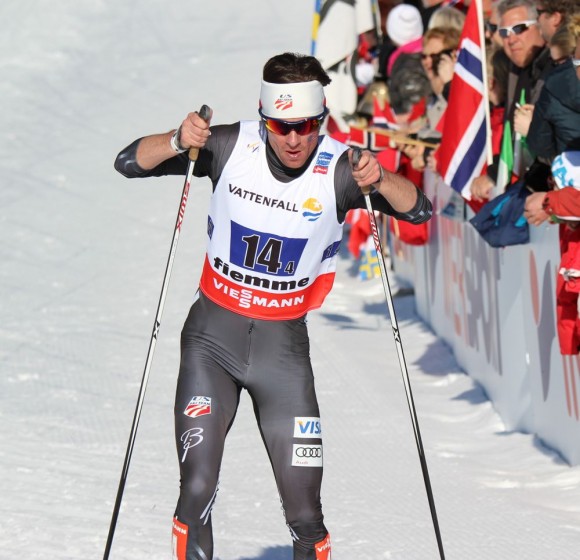
FasterSkier’s coverage of the 2013 FIS Nordic World Ski Championships in Val di Fiemme, Italy, is brought to you by the generous support of Fischer Sports.
VAL DI FIEMME, Italy — Channeling the energy of their female teammates with glitter and American flags on their faces, Andy Newell, Kris Freeman, Noah Hoffman and Tad Elliott started the 4×10 k World Championships relay with a simple goal on Friday: a top-eight finish. It was a “dream goal,” but they thought if they all skied 10 kilometers to their full potential it could happen in the 18-team field.
As can often happen in relays, however, the plan was replaced with a new one in the last leg when the race changed and opportunity presented itself. In a classic championship relay development, the leaders decided to slow to a snail’s pace at the front. When Elliott, the American anchor leg, realized it was slow enough to close in on, he decided to shoot for something more ambitious — he would “create some magic” and put the U.S. in the hunt for a medal.
Within the first three-kilometer loop he did exactly that, bringing the U.S. just behind Switzerland, Russia, Italy, Sweden, Norway and Germany. It was ultimately a short-lived break — the early expenditure caught up to Elliott and he faded to tenth, 1:01.4 behind Norway’s winning mark — but at the finish all four Americans were plainly “psyched” with how exciting it was to ski in the mix and with how close they might be to staying there in the future.
“I kind of risked it, but I think it’s really exciting moving into next year with the Olympics,” Elliott said. “If we all have a little bit better day it’s totally possible we could be in the mix, and hopefully I could save my accelerations to go with the group instead of trying to catch them. So we’re close.”
The three legs that preceded Elliott’s did not completely meet the team’s own expectations, though until the second leg things look good for the Americans. Newell skied what was by all accounts an “awesome” scramble leg, keeping the U.S. at the front of a dense group to hand off to Freeman in fifth position, just 4 seconds behind first.

Newell has come to expect good distance performances from himself, and on Friday he met those expectations.
“I think on a good day I can classic ski with the best in the world, so I was just hoping it would come together today,” he said. “I felt great and our skis were pretty good.
It was 50 degrees F at the start of the relay, which began at 1:30 p.m. local time. With some parts of the track in the shade and others under a blazing Italian sun, it was a tricky day for classic waxing for everyone. Norway’s scrambler, Tord Asle Gjerdalen, had to herring-bone on some of the steep climbs, as did several other teams. Newell thought that, on average, his skis worked well.
“My skis were really slow warming up but we added more top structure, because the snow was getting really saturated and wet, so I think they ended up being pretty quick,” he said. “A lot of the speed ended up depending on what track you were in — some down hills our skis were really fast, others they felt slow. But the body felt good and I thought I skied tactically well. It’s all about hammering the last few k’s in the first leg, and that’s what I tried to do.”
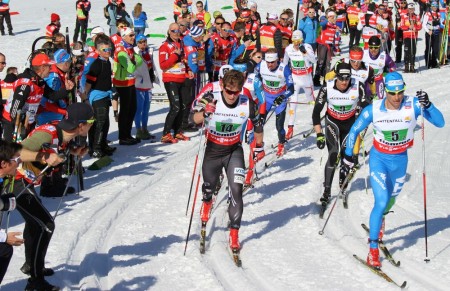
Freeman’s turn in the second position was where things broke down for the Americans. Skiing in the second classic position for the first time since last season, Freeman kept contact and led the field in places, but on the climb out of the stadium for his last lap the wheels inexplicably came off.
“I could tell I was working hard at the tops of the hills, but I felt like I was recovering pretty well,” Freeman said of his first two laps. “Then I just threw the hammer down going up the hill out of the third lap and I don’t remember much from there. I knew right then I was pretty blown and I just tried to mitigate the damage. I think it was the most painful race I’ve ever done; I was really screwed up afterwards.”
Barely conscious of how much time he’d bled before the tag-off of Hoffman, Freeman later figured out he finished his part of the race a minute down from the leaders in ninth place. The second leg is often when Norway, Sweden, and the usual medal contenders string out the race, and this World Championships was no exception. When Freeman became clear-headed again, a minute’s loss of time was less of a deficit than he expected.
“I was actually shocked at the end that I lost only a minute,” he said. “I think I would have lost four by the way I felt… The wheels just fell off real suddenly, I don’t know why. I wasn’t the only skier to have problems today. I know Lukas [Bauer] was having problems with the pace; Devon [Kershaw] was having problems with the pace. It’s not my best day but it was the best effort I had.”
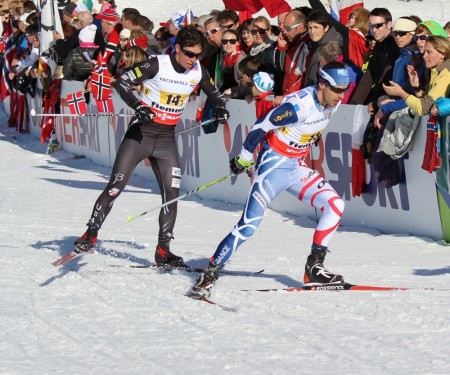
Hoffman, skating in the third position for the first time all season, left the stadium with France and Finland just in front of him. The nearby competition ended up working well for where he was; with other people to pace him he skied the fifth-fastest third leg and kept the U.S. in the exact same position at the end of the third leg— ninth place, a minute down.
“I felt good,” Hoffman said. “[France] was a good match, he was a good person to follow.”
France’s Robin Duvillard skied the fastest third leg of the field, and when Hoffman tagged to Elliott the U.S had dropped Finland and was less than two seconds behind France. Elliott moved out onto the course, learned of the pace slowing at the front, and decided to gun the leaders down.
“I heard those guys were walking up front, but I’ve been told that in many World Cups and never got on,” Elliott recalled.
Either the Americans were better-positioned this time or the drop in pace was more significant. Either way, when saw Norway, Sweden and the rest of the leaders going as slow as they could from across another part of the course, he decided they were close enough to reel in.
“I kind of leg go of the top-eight [goal] and really wanted to create some magic,” Elliott said. “I risked it.”
For a little while it looked as thought he would make history for his team. Elliott closed the gap within the first lap and left the stadium for the second time right on the back of the lead group of six skiers. But the leaders accelerated and decelerated erratically just as Elliott caught on, and the yo-yoing contributed to his re-loss of ground. Finland’s Matti Heikkinen passed Elliott back as the American, tired from his hard early effort, faded backwards to tenth, about a minute behind Norway’s winning time. Tenth is the same finish the U.S. had earlier this season in La Clusaz, France.
Though tenth was two places lower than the goal the Americans talked about the night before the realy, Elliott wouldn’t have done anything differently in hindsight.
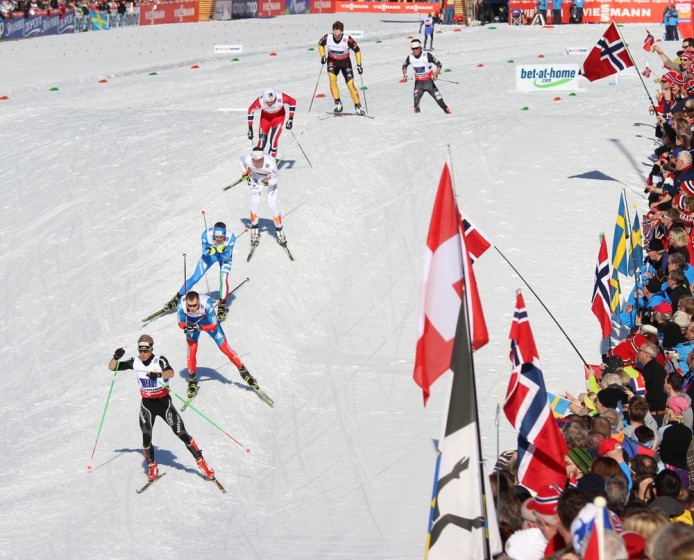
“I’d always rather fight for a top-five or a podium,” he said. “I mean, if it was magic out there maybe you get a podium if things go your way. I’d rather fight for some hardware than any other place.”
On paper the American’s performance doesn’t look like anything special, but there was something different about it that contributed to Elliott’s bold move in the last quarter, and to Newell’s top-level scramble. It might have been the face paint; it might have also been the spirit behind it.
“This relay was special to be a part of,” Elliott said. “It felt different — we were all into it. At the team meeting we could tell we all wanted a good day and I think we all had one… I think we found our groove, so looking forward to 2014 I think it’s going to be great.”
Anyone or anything that convinces Freeman to put red, white and blue paint on his cheek is certainly a memorable occasion. The 32-year-old doesn’t recall ever skiing with paint on his face before, but he couldn’t deny the momentum the women contributed to the entire team.
“The girls have done some amazing things this year and they have definitely show the power of belief and the power of team spirit,” he said. “We’re riding their success too and it’s really exciting to see.”
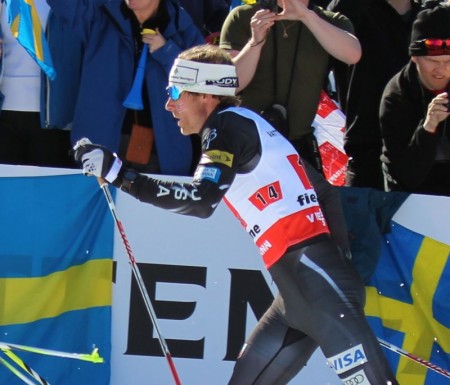
Elliott agreed there was power was in the paint.
“The women were telling us the magic of the face paint,” Elliott said. “Noah had glitter on and the rest of us went with flags, and I think there’s something special to it. I think it kind of creates some magic.”
On the whole, the American men almost put together a full, competitive relay on Friday. Freeman lost time on the second leg, but if all four skiers have a good day the next time they line up for a relay they figure they could be in serious contention.
“I’m psyched with where we’re at,” Hoffman said. “We didn’t put our four best legs together, but…if we’re in there when we tag to Tad and he doesn’t have to burn that match on his first lap, and he can do it on his last lap, I’m excited to watch.”
The Americans also had one more strong relay candidate waiting eagerly on the bench. Erik Bjornsen’s result from the 15 k freestyle didn’t result in a place on the squad, but he badly wanted to be and will continue to be a likely candidate in the future if he keeps skiing well.
“The more guys we have fighting for spots on the team I think the more competitive we’re going to be,” Hoffman concluded.
— Alex Matthews contributed reporting.
Audrey Mangan
Audrey Mangan (@audreymangan) is an Associate Editor at FasterSkier and lives in Colorado. She learned to love skiing at home in Western New York.



